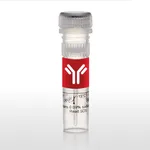Thermo Fisher Scientific PABPN1 Polyclonal Antibody
다른 상품 둘러보기
Applications
Tested Dilution
Publications
Western Blot (WB)
1:2,000-1:10,000
Immunohistochemistry (IHC)
1:200-1:2,000
Immunohistochemistry (Paraffin) (IHC (P))
1:200-1:2,000
Immunoprecipitation (IP)
2-10 µg/mg lysate
Product Specifications
Species Reactivity
Human
Host/Isotype
Rabbit / IgG
Class
Polyclonal
Type
Antibody
Immunogen
Region between residue 100 and 150 of human Poly(A) Binding Protein, Nuclear 1. if (typeof window.$mangular === undefined || !window.$mangular) { window.$mangular = {}; } $mangular.antigenJson = \[{targetFamily:PABPN1,uniProtId:Q86U42-1,ncbiNodeId:9606,antigenRange:100-150,antigenLength:306,antigenImageFileName:A303-524A_PABPN1_Q86U42-1_Rabbit.svg,antigenImageFileNamePDP:A303-524A_PABPN1_Q86U42-1_Rabbit_PDP.jpeg,sortOrder:1}\]; $mangular.isB2BCMGT = false; $mangular.isEpitopesModalImageMultiSizeEnabled = true;
View immunogen .st0{fill:#FFFFFF;} .st1{fill:#1E8AE7;}
Conjugate
Unconjugated Unconjugated Unconjugated
Form
Liquid
Concentration
0.20 mg/mL
Purification
Antigen affinity chromatography
Storage buffer
TBS, pH 7.0 to 8.0, with 0.1% BSA
Contains
0.09% sodium azide
Storage conditions
4° C
Shipping conditions
Wet ice
Product Specific Information
The recommended shelf life for this product is 1 year from date of receipt.
Application Note: For IHC, epitope retrieval with citrate buffer pH 6.0 is recommended for FFPE tissue sections.
Target Information
This gene encodes an abundant nuclear protein that binds with high affinity to nascent poly(A) tails. The protein is required for progressive and efficient polymerization of poly(A) tails at the 3ends of eukaryotic transcripts and controls the size of the poly(A) tail to about 250 nt. At steady-state, this protein is localized in the nucleus whereas a different poly(A) binding protein is localized in the cytoplasm. This gene contains a GCG trinucleotide repeat at the 5 end of the coding region, and expansion of this repeat from the normal 6 copies to 8-13 copies leads to autosomal dominant oculopharyngeal muscular dystrophy (OPMD) disease. Related pseudogenes have been identified on chromosomes 19 and X. Read-through transcription also exists between this gene and the neighboring upstream BCL2-like 2 (BCL2L2) gene.
For Research Use Only. Not for use in diagnostic procedures. Not for resale without express authorization.
배송/결제/교환/반품 안내
배송 정보
| 기본 배송비 |
| 교환/반품 배송비 |
|
|---|---|---|---|
| 착불 배송비 |
| ||
| 교환/반품 배송비 |
| ||
결제 및 환불 안내
| 결제수단 |
|
|---|---|
| 취소 |
|
| 반품 |
|
| 환급 |
|
교환 및 반품 접수
| 교환 및 반품 접수 기한 |
|
|---|---|
| 교환 및 반품 접수가 가능한 경우 |
|
| 교환 및 반품 접수가 불가능한 경우 |
|
교환 및 반품 신청
| 교환 절차 |
|
|---|---|
| 반품 절차 |
|

